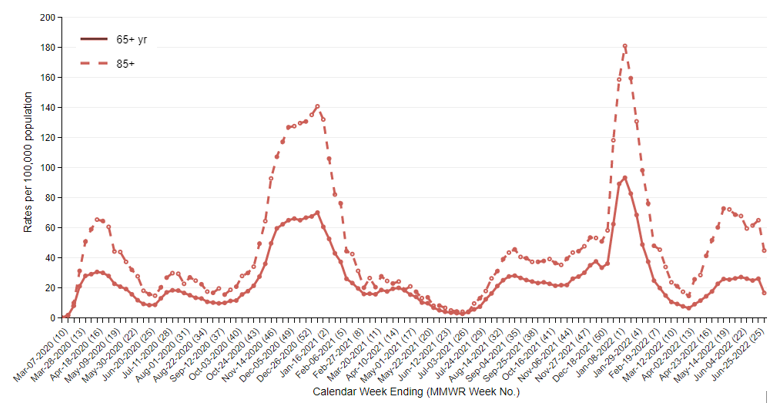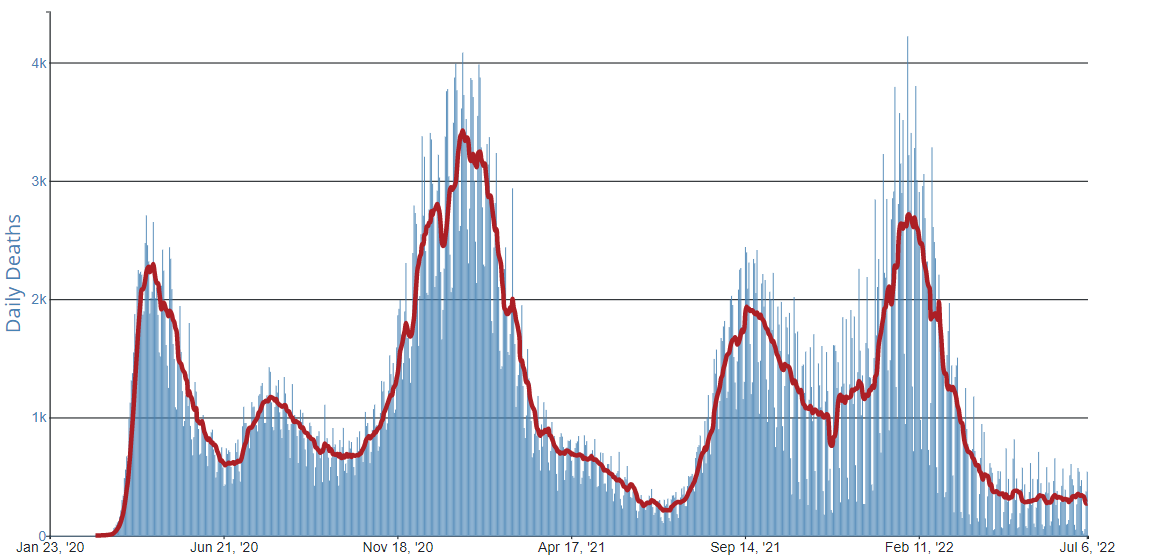Recommendations for Fully Vaccinated People
COVID-19 Homepage
The Best Defense
Interpretive Summary for July 8, 2022
The Best Defense
Twenty million more children became eligible for COVID-19 vaccination on June 18, when CDC expanded recommendations to include children ages 6 months through 5 years. CDC now recommends COVID-19 primary series vaccines for everyone ages 6 months and older and COVID-19 boosters for everyone ages 5 years and older, if eligible. CDC’s COVID Data Tracker shows that over 267,000 children in this youngest age group have received at least one dose of either the three-dose pediatric Pfizer vaccine or the two-dose pediatric Moderna vaccine since June 18. Over 654,000 children ages 5 to 11 years have received a booster.
COVID-19 vaccines are safe and continue to undergo the most intensive safety monitoring in U.S. history. Not all places that offer adult vaccines, like pharmacies, are able to vaccinate young children. COVID-19 vaccines for young children are primarily administered at health departments and pediatrician offices, so it’s always a good idea to call ahead to schedule an appointment.
Vaccinating everyone ages 6 months and older is the best defense against serious illness, hospitalization, and death related to COVID-19. Even healthy children without underlying medical conditions can get severe COVID-19 or suffer from long-term health complications after recovering from COVID-19. To find COVID-19 vaccines for children, parents and caregivers can talk to a doctor, nurse, pharmacist, call the local health department or clinic, or visit vaccines.gov.
Note to Readers: Parents and caregivers can learn more about COVID-19 vaccines for children by visiting 6 Things to Know about COVID-19 Vaccination for Children.
- COVID Data Tracker’s COVID-19 Vaccinations in the United States tab now includes national and jurisdictional data on first booster doses for people ages 5 years and older.
- COVID Data Tracker’s COVID-19 Vaccinations in the United States tab now includes the national count of children under age 5 years who have received at least one dose of a COVID-19 pediatric vaccine since they were recommended on June 18, 2022.
- COVID Data Tracker’s Vaccination Demographics and Vaccination Demographic Trends tabs now include the population ages 5–11 years in first booster dose visualizations.
- COVID Data Tracker now includes a new Post COVID Conditions page. This new page highlights data from the Innovative Support for Patients with SARS-CoV-2 Infections Registry (INSPIRE)External study.
- COVID-19 Vaccine Provider Availability and Vaccination Coverage Among Children Aged 5–11 Years — United States, November 1, 2021–April 25, 2022
- Interim Recommendations of the Advisory Committee on Immunization Practices for Use of Moderna and Pfizer-BioNTech COVID-19 Vaccines in Children Aged 6 Months–5 Years — United States, June 2022
- Factors Associated with Severe Outcomes Among Immunocompromised Adults Hospitalized for COVID-19 — COVID-NET, 10 States, March 2020–February 2022
COVID-19 Community Levels
As of July 7, 2022, there are 666 (20.7%) counties, districts, or territories with a high COVID-19 Community Level, 1,218 (37.8%) counties with a medium Community Level, and 1,331 (41.3%) counties with a low Community Level. Compared to last week, this represents an increase (+1.3 percentage points) in the number of high-level counties, an increase (+2.4 percentage points) in the number of medium-level counties, and a corresponding decrease (−3.7 percentage points) in the number of low-level counties. 49 out of 52 jurisdictions* had high- or medium-level counties this week. Rhode Island, New Hampshire, and Washington, D.C., are the only jurisdictions to have all counties at low Community Levels.
To check your COVID-19 Community Level, visit COVID Data Tracker. To learn which prevention measures are recommended based on your COVID-19 Community Level, visit COVID-19 Community Level and COVID-19 Prevention.
*Includes the 50 states, the District of Columbia, and Puerto Rico.
Reported Cases
As of July 6, 2022, the current 7-day moving average of daily new cases (106,549) decreased 3.9% compared with the previous 7-day moving average (110,875). A total of 88,056,795 COVID-19 cases have been reported in the United States as of July 6, 2022.
Variant Proportions
CDC Nowcast projections* for the week ending July 2, 2022, estimate that the combined national proportion of lineages designated as Omicron will continue to be 100% with the predominant Omicron lineage being BA.5, projected at 53.6% (95% PI 49.5-57.6%).
There are several lineages of Omicron, and within each are multiple sublineages. The national proportion of BA.2.12.1 is projected to be 27.2% (95% PI 24.23-30.3%). BA.4 is projected to be 16.5% (95% PI 13.9-19.4%) and BA.2 is projected to be 2.8% (95% PI 2.4-3.3%). See COVID DataTracker for current data.
88,056,795
Total Cases Reported
88,056,795
Total Cases Reported
106,549
Current 7-Day Average**
106,549
Current 7-Day Average**
110,875
Prior 7-Day Average
110,875
Prior 7-Day Average
-3.9%
Change in 7-Day Average since Prior Week
-3.9%
Change in 7-Day Average since Prior Week
*The median time from specimen collection to sequence data reporting is about 3 weeks. As a result, weighted estimates for the most recent few weeks may be unstable or unavailable. CDC’s Nowcast is a data projection tool that helps fill this gap by generating timely estimates of variant proportions for variants that are circulating in the United States. View Nowcast estimates on CDC’s COVID Data Tracker website on the Variant Proportions page.
**Historical cases are excluded from daily new cases and 7-day average calculations until they are incorporated into the dataset for the applicable date. Of 536,361 historical cases reported retroactively, 2,698 were reported in the current week and none were reported in the prior week.
Vaccinations
The U.S. COVID-19 Vaccination Program began December 14, 2020. As of July 6, 2022, 597.7 million vaccine doses have been administered in the United States. Overall, about 260.3 million people, or 78.4% of the total U.S. population, have received at least one dose of vaccine. About 222.5 million people, or 67.0% of the total U.S. population, have been fully vaccinated.* Of those fully vaccinated, about 106.6 million people have received a booster dose,** but 50.1% of the total booster-eligible population has not yet received a booster dose.
CDC’s COVID Data Tracker displays vaccination trends by age group, race/ethnicity, and urban/rural status. To see trends by age group and race/ethnicity, visit the tab. To see trends by urban/rural status, visit the COVID-19 Vaccination Equity tab.
597,655,035
Vaccine Doses Administered
597,655,035
Vaccine Doses Administered
260,327,743
People who received at least one dose
260,327,743
People who received at least one dose
222,455,652
People who are fully vaccinated*
222,455,652
People who are fully vaccinated*
78.4%
Percentage of the U.S. population that has received at least one dose
78.4%
Percentage of the U.S. population that has received at least one dose
67.0%
Percentage of the U.S. population that has been fully vaccinated*
67.0%
Percentage of the U.S. population that has been fully vaccinated*
+0.1
Percentage point increase from last week
+0.1
Percentage point increase from last week
+0.1
Percentage point change from last week
+0.1
Percentage point change from last week
*Represents the number of people who have received the second dose in a two-dose COVID-19 vaccine series (such as the Pfizer-BioNTech or Moderna vaccines) or one dose of the single-shot Johnson & Johnson’s Janssen vaccine.
**Represents the number of people who are fully vaccinated and have received another dose of COVID-19 vaccine since August 13, 2021. This includes people who received their first additional dose or booster dose.
Hospitalizations
New Hospital Admissions
The current 7-day daily average for June 29–July 5, 2022, was 5,080. This is a 3.1% increase from the prior 7-day average (4,930) from June 22–28, 2022.
4,906,251
Total New Admissions
4,906,251
Total New Admissions
5,080
Current 7-Day Average
5,080
Current 7-Day Average
4,930
Prior 7-Day Average
4,930
Prior 7-Day Average
+3.1%
Change in 7-Day Average
+3.1%
Change in 7-Day Average
The start of consistent reporting of hospital admissions data was August 1, 2020.
Daily Trends in Number of New COVID-19 Hospital Admissions in the United States

New admissions are pulled from a 10 am EDT snapshot of the HHS Unified Hospital Data – Analytic Dataset. Due to potential reporting delays, data from the most recent 7 days, as noted in the figure above with the grey bar, should be interpreted with caution. Small shifts in historic data may also occur due to changes in the Centers for Medicare & Medicaid Services (CMS) Provider of Services file, which is used to identify the cohort of included hospitals.
COVID-NET: Hospitalization Rates by Vaccination Status in Adults Ages ≥65 Years
CDC’s Coronavirus Disease 2019-Associated Hospitalization Surveillance Network (COVID-NET) shows that overall rates of COVID-19-associated hospitalizations have increased since the week ending April 2, 2022. Notably, rates among adults ages 65 years and older have seen a sharp increase, from 6.7 per 100,000 population on April 2, to 25.1 per 100,000 population on June 18. Among this group, adults ages 85 and older have had the largest increase in hospitalization rates in this same time period, increasing from 14.8 per 100,000 population on April 2 to 61.7 per 100,000 population on June 18.
Rates of COVID-19-Associated Hospitalizations among Adults Ages ≥65 Years

The Coronavirus Disease 2019 (COVID-19)-Associated Hospitalization Surveillance Network (COVID-NET) is an additional source for hospitalization data collected through a network of more than 250 acute-care hospitals in 14 states (representing ~10% of the U.S. population). Detailed data on patient demographics, including race/ethnicity, underlying medical conditions, medical interventions, and clinical outcomes, are collected using a standardized case reporting form.
Deaths
The current 7-day moving average of new deaths (273) has decreased 20.9% compared with the previous 7-day moving average (345). As of July 6, 2022, a total of 1,015,070 COVID-19 deaths have been reported in the United States.
1,015,070
Total Deaths Reported
1,015,070
Total Deaths Reported
273
Current 7-Day Average*
273
Current 7-Day Average*
345
Prior 7-Day Average
345
Prior 7-Day Average
-20.9%
Change in 7-Day Average Since Prior Week
-20.9%
Change in 7-Day Average Since Prior Week
*Historical deaths are excluded from the daily new deaths and 7-day average calculations until they are incorporated into the dataset by their applicable date. Of 21,756 historical deaths reported retroactively, none were reported in the current week; and 41 were reported in the prior week.
Daily Trends in Number of COVID-19 Deaths in the United States Reported to CDC

7-Day moving average
 More Death Data
More Death DataTesting
The percentage of COVID-19 NAATs (nucleic acid amplification tests)* that are positive (percent positivity) is increasing in comparison to the previous week. The 7-day average of percent positivity from NAATs is now 17.5%. The 7-day average number of tests reported for June 24–30, 2022, was 414,614, down 22.4% from 534,464 for the prior 7 days.
916,128,298
Total Tests Reported
916,128,298
Total Tests Reported
414,614
7-Day Average Tests Reported
414,614
7-Day Average Tests Reported
17.5%
7-Day Average % Positivity
17.5%
7-Day Average % Positivity
15.4%
Previous 7-Day Average % Positivity
15.4%
Previous 7-Day Average % Positivity
+2.12
Percentage point change in 7-Day Average % Positivity since Prior Week
+2.12
Percentage point change in 7-Day Average % Positivity since Prior Week
*Test for SARS-CoV-2, the virus that causes COVID-19
Wastewater Surveillance
COVID Data Tracker’s tab tracks levels, changes, and detections of SARS-CoV-2* viral RNA in wastewater at over 1,000 testing sites across the country.
Currently, most of the country is reporting moderate to high SARS-CoV-2 levels in wastewater. Around 38% of sites are currently seeing some of the highest levels for those sites since December 1, 2021. About half of all sites reporting wastewater data are experiencing a decrease in SARS-CoV-2 levels, and about half are reporting an increase. It’s important to note that even a small increase when levels are low can appear like a dramatic increase in the percent change.
For more information on how to use wastewater data visit CDC’s website.
*The virus that causes COVID-19
SARS-CoV-2 Levels in Wastewater by Site


0% means levels are the lowest they have been at the site; 100% means levels are the highest they have been at the site.





